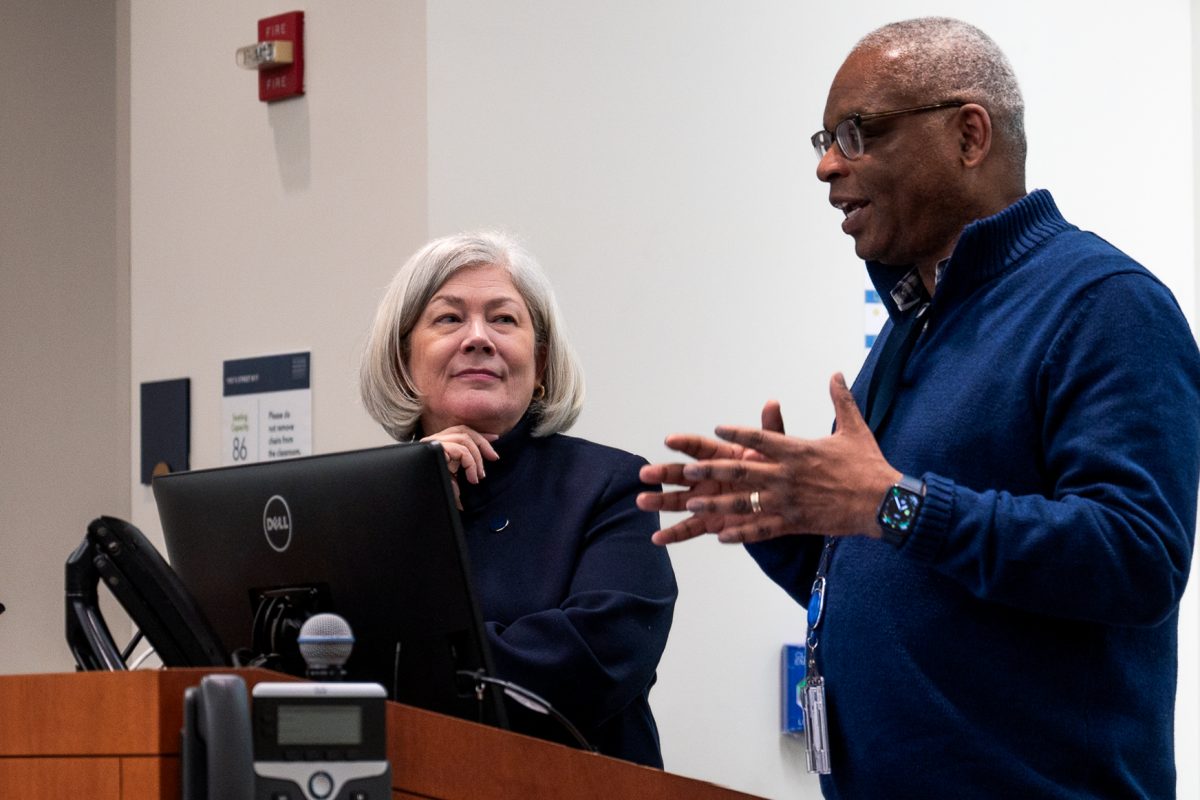University President Ellen Granberg updated neighborhood residents on GW’s plans for the Charles E. Smith Center and the I Street Mall at the Foggy Bottom Association meeting Tuesday.
Granberg told the FBA that University officials halted the plan to fill in the Smith Center pool and replace it with a basketball practice facility last week because officials received “new information” from the project contractor’s final analysis that revealed the building would need to be closed for more than a year to complete the work. She also provided an update to the FBA on officials’ plans to renovate the pedestrian mall on I Street between 23rd and 24th streets and design the 2027 Foggy Bottom Campus Plan.
Community members relayed concerns about student protests and community disturbances from GW students who live in neighborhoods off campus.
Here are some of the meeting’s highlights:
Officials seek alternative plan for basketball practice facility
Granberg said officials had to pause their Smith Center renovation plans because GW did not have an alternative space for community members to use if the center closed for a full year to fill in the pool and build a basketball practice facility. She said officials are looking for “other options” for the swimming and diving and basketball teams to practice during renovations.
“We’ll of course come back to the community before we get too far down the road,” Granberg said.
The Smith Center’s construction plan initially involved expanding the building by 10 feet toward G Street, with work beginning around Labor Day and ending in mid-to-late 2025.
She said officials are also looking for a “great” swimming facility for the swim, dive and water polo teams to use during the year. Director of Athletics and Recreation Tanya Vogel said in March that the Smith Center’s pool — which is 25 meters, half the length of an Olympic-sized pool — is “insufficient” for the teams to practice.
Officials look to add shaded areas to I Street Mall construction plan
Granberg said she knows there are “concerns” from community members about the removal of trees in the initial construction plan for the I Street Mall. Officials plan to conduct “major” landscaping, remove rat-burrowing areas, add lighting and reconfigure seating in the space.
Granberg said officials need to renovate the area because there are “serious issues” with rat populations and pedestrian safety, but that officials are looking at options to incorporate more shade in the renovation plan.
“We don’t want to promise something that we can’t deliver on and so we need to put it through that process and then we’ll come back,” Granberg said.
Granberg responds to community members’ concerns about student protests, disturbances from students living off campus
A community member asked Granberg if officials were monitoring student protests and how officials would respond if a similar situation to that at Columbia University, where police swept an encampment to arrest more than 100 pro-Palestinian protesters, happened at GW.
Granberg said the University is committed to balancing students’ safety with “calm” educational conditions, and the Division for Student Affairs works with students on an ongoing basis to determine how they can express their beliefs on campus while complying with University policies.
She said the University has “pretty clear” rules about what types of protests are permitted, which have guided the disciplinary decisions officials made this past year.
“What every university is doing, and GW is doing the same thing, is figuring out how we balance safety and a robust educational environment,” Granberg said.
Community members at the meeting reported students living off campus in Foggy Bottom neighborhoods throwing bottles at houses from apartment buildings and hosting loud parties. Kevin Days, the director of community relations, said Christy Anthony, the director of Student Rights & Responsibilities, responds to complaints about off-campus students. He added that officials can work on hosting meals for students and community members to meet.
Officials plan to engage community members in 2027 campus planning renewal
Granberg said internal preparation for the 2027 Foggy Bottom campus planning renewal is underway, and that the University will hire a firm to construct a campus master plan, which she said is a “standard way” universities create large-scale campus plans.
GW formed its current campus plan in 2007, which is set to expire in 2026.
Granberg said the creation of a campus master plan involves “robust” community engagement.
“That involves an enormous amount of information gathering from the community — inside the University and the surrounding community,” Granberg said.





